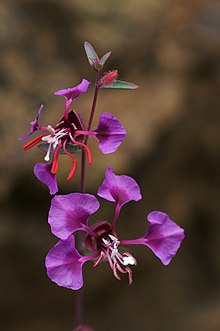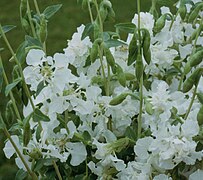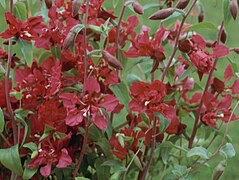Clarkia unguiculata
| Clarkia unguiculata | |
|---|---|

| |
| Scientific classification | |
| Kingdom: | Plantae |
| Clade: | Tracheophytes |
| Clade: | Angiosperms |
| Clade: | Eudicots |
| Clade: | Rosids |
| Order: | Myrtales |
| Family: | Onagraceae |
| Genus: | Clarkia |
| Species: | C. unguiculata
|
| Binomial name | |
| Clarkia unguiculata | |
| Synonyms[2] | |
| |
Distribution
[edit]Clarkia unguiculata is a species of wildflower known by the common name elegant clarkia or mountain garland.[3] This plant is endemic to California, where it is found in many woodland habitats.[4] It grows along the coastal ranges of Mendocino and San Diego. Clarkia unguiculata can also be found in the Sierran foothills. Specifically it is common on the forest floor of many oak woodlands, along with typical understory wildflowers that include Calochortus luteus, Cynoglossum grande and Delphinium variegatum.[5] It flowers in the summer and fall and thrives in somewhat neutral soil pH.
Morphology
[edit]C. unguiculata presents a spindly, hairless, waxy stem with a red hue. The species can grow up to 3 ft (0.9 m) tall with a small number of leaves populating the stem.[6] The showy flowers have hairy, fused sepals forming a cup beneath the corolla, and four petals each one to 2.5 cm (1.0 in) long.[7] The paddle-like petals are a shade of pink to reddish to purple and are slender and diamond-shaped or triangular in a raceme formation, in which each flower is connected to the main stalk by a pedicel, a short stem extension.[6] There are eight long stamens, the outer four of which have large red anthers. The stigma protrudes from the flower and can be quite large.
Ecology
[edit]Clarkia unguiculata is a simple species as it interacts mainly with its pollinators, these being a variety of bees, butterflies and some bats.[6] The main pollinator is the Hesperapis regularis, a native species of bees found in similar environments to C. unguiculata.[8] This plant has the ability to self-pollinate.[9] The ability to self-pollinate means the species is not heavily reliant on the presence of pollinators like bees or butterflies. Despite having a mutualistic relationship with other species, this flower can persevere by itself if certain conditions are met.
Commercial cultivars
[edit]-
'Albatross'
-
'Firebrand'
-
'Gloriosa'
-
'Lilac'
-
'Tall Double Mix'
References
[edit]- ^ "Clarkia unguiculata". NatureServe.
- ^ "Clarkia unguiculata". Plants of the World Online. Royal Botanic Gardens, Kew. Retrieved 16 November 2024.
- ^ USDA, NRCS (n.d.). "Clarkia unguiculata". The PLANTS Database (plants.usda.gov). Greensboro, North Carolina: National Plant Data Team. Retrieved 29 November 2019.
- ^ Calscape. "Elegant Clarkia". calscape.org. Retrieved 2024-11-16.
- ^ C. Michael Hogan. 2009. Gold Nuggets: Calochortus luteus, GlobalTwitcher.com, ed. N. Stromberg
- ^ a b c "Lady Bird Johnson Wildflower Center - The University of Texas at Austin". www.wildflower.org. Retrieved 2024-11-16.
- ^ Jepson Manual. 1993. Clarkia unguiculata
- ^ Peach, Kristen; Mazer, Susan J. (April 2019). "Heteranthery in Clarkia : pollen performance of dimorphic anthers contradicts expectations". American Journal of Botany. 106 (4): 598–603. doi:10.1002/ajb2.1262. ISSN 0002-9122.
- ^ Moeller, David A.; Geber, Monica A. (2005). "Ecological Context Of The Evolution Of Self-Pollination In Clarkia Xantiana: Population Size, Plant Communities, And Reproductive Assurance". Evolution. 59 (4): 786. doi:10.1554/04-656. ISSN 0014-3820.
External links
[edit]![]() Media related to Clarkia unguiculata at Wikimedia Commons
Media related to Clarkia unguiculata at Wikimedia Commons
- NatureServe secure species
- Clarkia
- Endemic flora of California
- Flora of the Sierra Nevada (United States)
- Natural history of the California chaparral and woodlands
- Natural history of the California Coast Ranges
- Natural history of the Peninsular Ranges
- Natural history of the Santa Monica Mountains
- Natural history of the Transverse Ranges
- Plants described in 1837
- Myrtales stubs






